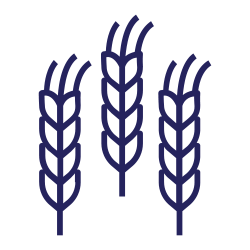Section Title
Targeting Higher Cereal Plant Stands: Risks and Rewards
- Wheat
- Winter Wheat
As spring approaches, it’s time to start thinking about target plant stands in your spring cereals. Plant populations influence all three of the primary determinants of yield: 1. number of heads per acre, 2. number of kernels per head and 3. weight per kernel. It’s a good idea to have a conversation with your seed growers and representatives to talk about how the variety you’ve selected will perform under different target plant populations.
Research out of North Dakota has found that optimum seeding rate is dependent on both cultivar and environment. The study found that the optimum seeding rate for low yielding environments was 38 seeds/ft2, while the optimum for high yielding environments was 31 seeds/ft2. In general, across all environments, the optimum was determined to be 32 seeds/ft2. This translates to a wide range of target plant stands, from 14 plants/ft2 to 46 plants/ft2.
Here in Manitoba, the provincial recommendation is to target a plant stand of 23-29 plants/ft2. A study conducted at Manitoba Agriculture Diversification Centres across the province (Arborg, Carberry, Melita, Roblin) was designed to see if the provincial recommendation was still optimal for current cereal genetics. The study looked at 5 target plant populations (15, 21, 27, 33, and 39 plants/ft2), and found the following:
- For wheat, increased yields were observed with higher target plant stands (but no significant yield difference between plant stands of 21-39 plants/ft2)
- For barley, no significant increases in yield from higher plant stands were observed
In general, the study found that the current recommendations for target plant stands for cereals in Manitoba are sufficient. More information from this study can be found at: https://www.gov.mb.ca/agriculture/crops/seasonal-reports/pubs/seeding-rates-spring-cereals.pdf
If you are considering increasing your target for the upcoming growing season, here are some things to consider:
Advantages
- Higher plant populations can lower weed competition.
- A uniform stand will hopefully translate into improved yield, kernel uniformity and quality.
- Potential to better manage fungicide and insecticide application, because of uniformity at critical pesticide timings. This is especially helpful in areas where fusarium head blight and wheat midge are pests of concern.
- Uniformity can also make swathing or straight cutting easier at harvest.
Disadvantages
- Increased potential for lodging, in turn affecting yield and quality.
- Thicker canopies can lead to increased disease pressure.
- Plants may also be stressed from more inter-plant competition for nutrients, light and moisture.
Seeding rate calculators are a great resource available to help make seeding decisions. Of course, they are only as accurate as the information you enter into them. Important pieces of information to consider include:
- Target plant stand: talk to your agronomist, seed grower, or representative, and take provincial recommendations into consideration.
- Thousand kernel weight (TWK): the weight of a thousand seeds. This can vary dramatically from variety to variety.
- Germination rate: if this is number is not provided by the seed company, a simple germination test can be done at home.
- Emergence mortality: many farmers and agronomists have found a 5-10% mortality rate can be assumed. This number may also be provided by the seed company.









